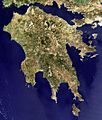Isthmus of Corinth facts for kids
The Isthmus of Corinth is a thin strip of land in Greece. It connects the large Peloponnese peninsula to the rest of mainland Greece. It's located close to the city of Corinth. The word "isthmus" comes from an old Greek word meaning "neck." This name fits because the land is very narrow.
To the west of the Isthmus, you'll find the Gulf of Corinth. To the east is the Saronic Gulf. Since 1893, the Corinth Canal has cut through this 6.3-kilometer-wide land bridge. This canal makes the Peloponnese act like an island.
Today, several road bridges and even a special bridge that can go underwater connect the mainland side of the isthmus with the Peloponnese side.
Contents
Ancient Dreams: Building a Shortcut
For a very long time, people in Ancient Greece dreamed of a shortcut. They wanted to avoid sailing all the way around the Peloponnese peninsula.
Early Attempts to Dig a Canal
The first known attempt to dig a canal here was by a ruler named Periander (or Periandros) in the 7th century BC. He had to stop the project because it was too difficult. Instead, he built a simpler stone ramp over land. This ramp was called the Diolkos. It was used to drag ships across the land. You can still see parts of the Diolkos today, right next to the modern canal.
Roman Empire's Efforts
Later, when the Roman Republic (which became the Roman Empire) took control of Greece, they also tried to build a canal. Julius Caesar saw how useful a canal would be for his new city, Colonia Laus Iulia Corinthiensis.
Around AD 32, during the rule of Tiberius, engineers tried to dig a canal. But they didn't have modern machines. They had to use an old Egyptian method: rolling boats on logs, just like the Egyptians rolled huge stone blocks to build their pyramids.
In AD 67, the Roman emperor Nero ordered 6,000 slaves to dig the canal using spades. Nero was known for loving Greek culture. However, Nero died the next year. His successor, Galba, stopped the project. It seemed too expensive to finish.
Protecting Ancient History
Near the modern canal, there's an ancient stone path. This path was once used to drag ships over land. People are very concerned about protecting this important historical site. Greek campaigners are asking their government to do more to save this archaeological treasure.
Images for kids
See also
 In Spanish: Istmo de Corinto para niños
In Spanish: Istmo de Corinto para niños




